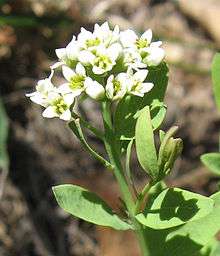Comandra
| Comandra | |
|---|---|
 | |
| Scientific classification | |
| Kingdom: | Plantae |
| (unranked): | Angiosperms |
| (unranked): | Eudicots |
| (unranked): | Core eudicots |
| Order: | Santalales |
| Family: | Santalaceae |
| Genus: | Comandra Nutt. |
| Species: | C. umbellata |
| Binomial name | |
| Comandra umbellata (L.) Nutt. | |
| Synonyms | |
| |
Comandra is a monotypic genus[1] containing the single species Comandra umbellata. Its common names include bastard toadflax, umbellate bastard toadflax, and common comandra.[2] The plant has a disjunct distribution;[1] its four subspecies occur in North America and the Mediterranean.[3]
Description
Comandra is a perennial herb growing about 8 to 34 cm tall. The leaves are up to 3.3 cm long and are alternately arranged. The flowers lack petals, but have five greenish-white sepals; the flowers are perfect, containing both male and female structures. The flowers are insect-pollinated. The fruit is a drupe 4-6mm thick. It prefers to grow in drier soils.[4][5]
Subspecies include:[6]
- C. u. ssp. californica – California bastard toadflax
- C. u. ssp. pallida – pale bastard toadflax, pine bastard toadflax
- C. u. ssp. umbellata
C. umbellata is hemiparasitic; it is not holoparasitic as it obtains some nutrition through photosynthesis.[7] It has a wide host range, parasitizing over 200 known plant species.[4] These include: Acer, Antennaria, Aster, Betula, Carex, Solidago, Fragaria, Populus, oaks, Rosa, Rubus, Vaccinium and some grasses.[7][5]
In Europe the common English name bastard toadflax is used for plants of the genus Thesium.
Uses
A decoction of the plant parts was made by the Navajo people for narcotic and other medicinal usage. In times of food shortage, the berries were used by Native Americans as a food source,[8] and though small, they have a sweet taste.[9]
Pathogens
C. umbellata is the alternate host for the comandra blister rust (Cronartium comandrae), a rust fungus that affects pine species in North America. Comandra blister rust can cause tree losses of up to 7% in some regions where it is common.[10]
When C. umbellata is infected by the rust aeciospores from the pine host, yellow, blister-like spots bearing urediniospores appear on the leaves of the plant within 20 days. In the following weeks, teliospores develop on brown, hairlike telia that germinate to produce basidiospores, the fungal life stage capable of infecting pines.[11]
References
- 1 2 Der, J. P.; Nickrent, D. L. (2008). "A molecular phylogeny of Santalaceae (Santalales)" (PDF). Systematic Botany. 33 (1): 107–16. doi:10.1600/036364408783887438.
- ↑ Comandra umbellata. NatureServe. 2012.
- ↑ Mabberley, D. J. (2000). The Plant Book: A Portable Dictionary of the Vascular Plants. New York: Cambridge University Press.
- 1 2 Comandra umbellata. Arches National Park, Utah. United States National Park Service.
- 1 2 Rhoads, Ann; Block, Timothy. The Plants of Pennsylvania (2 ed.). Philadelphia Pa: University of Pennsylvania press. ISBN 978-0-8122-4003-0.
- ↑ Comandra umbellata. Integrated Taxonomic Information System (ITIS).
- 1 2 Moss, E. H. (1926). "Parasitism in the genus Comandra". New Phytologist. 25 (4): 264–276. doi:10.1111/j.1469-8137.1926.tb06695.x.
- ↑ Betty B. Derig and Margaret C. Fuller (2001). Wild Berries of the West. Missoula, Montana: Mountain Press Publishing Company. p. 159. ISBN 0-87842-433-4.
- ↑ "Bastard Toadflax (Comandra umbellata)". Native Wildflowers of the North Dakota Grasslands. Northern Prairie Wildlife Research Center. Retrieved 3 December 2013.
- ↑ Woods, A. J.; et al. (2000). "Predicted impacts of hard pine stem rusts on lodgepole pine dominated stands in central British Columbia". Canadian Journal of Forest Research. 30 (3): 476–481. doi:10.1139/cjfr-30-3-476.
- ↑ Johnson, D. W. (1986). "Comandra Blister Rust". Forest Insect & Disease Leaflet. 62.
